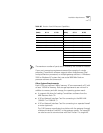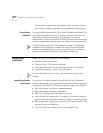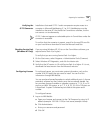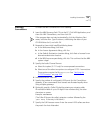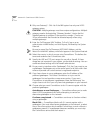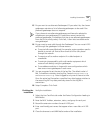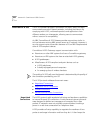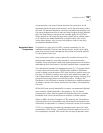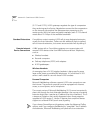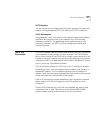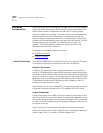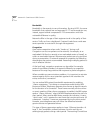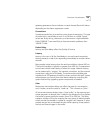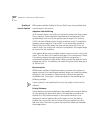
Overview of H.323 399
connection alive until one of the parties ends the connection. A call
tear-down signal indicates to the network, and to the other party, when a
call ends. On standard telephone networks, the telephone company uses
this signal to determine when to start and stop charging for long distance
calls, but long distance charges do not normally apply to H.323 calls.
Other reasons for call setup and tear-down signals are to indicate when
an IP network can release bandwidth to support other calls, and to
inform other devices, such as voice mail systems, when to stop their
conversation-related activities.
Negotiated Voice
Compression
IP networks can carry a lot of traffic, creating competition for the
available bandwidth. Devices have the best access, and the least delay,
when they communicate messages by using fewer and smaller packets.
This also means lower cost.
Voice compression offers a way to reduce the number and size of the
data packets needed to carry each second of a voice conversation.
However, voice compression needs high-speed processors to remove the
redundancies that are inherent in the way standard voice is represented.
The international standard for representing voice (G.711) requires 64 Kb
for each second of conversation. NBX Business and Basic Telephones
contain a digital signal processor (DSP) that transforms spoken voice into
this form. An Ethernet interface, also within each telephone, breaks up
the 64 Kbps stream into frames, adds addressing and error checking, and
dumps the voice-data frames (now 83 Kbps) onto a 10 Mbps LAN.
Elsewhere on the LAN (local or remote), the destination telephone detects
its address, recovers the frames, extracts the bit stream, and reproduces
the voice.
While LANs have enough bandwidth to support uncompressed digitized
voice transfers, WAN bandwidth is less generous. For this reason,
compression is often used to squeeze the digitized voice into a smaller
bandwidth that can be carried across an Internet in smaller packets.
When an NBX call passes through an H.323 gateway, the ConneXtions
software performs an intermediate step that extracts the essential voice
information, encapsulates it in packets, and sends it across an IP network.
G.723 is a compression standard that represents each second of voice
conversation with 6.3 Kbps. ConneXtions software supports the use of
this compression standard. With more than one way to represent voice



